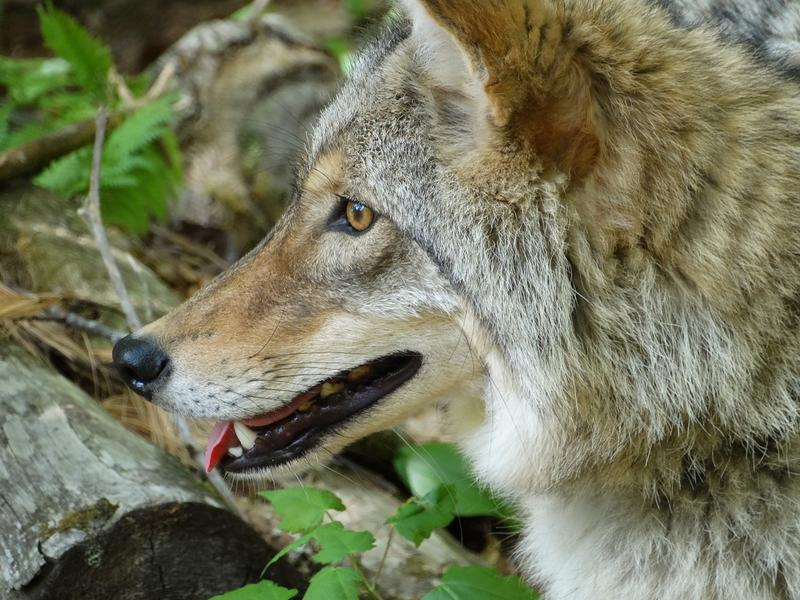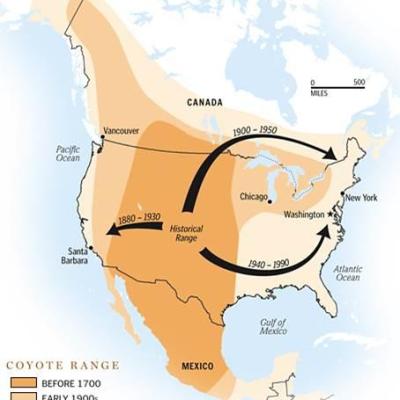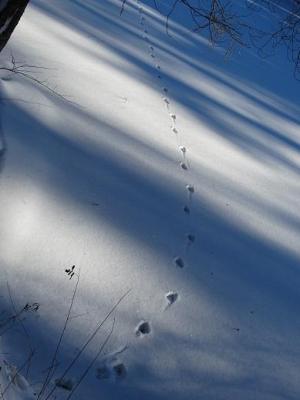- Tags:
- Wildlife,
- Something Wild

The Eastern Coyote is here to stay. Credit Christine Schadler
Chris Shadler is a wild canid biologist, and for about 25 years, her specialty has been the coyote. The first confirmed case of coyotes in New Hampshire was an individual found in a trap in Holderness in the mid 1940s. But they have likely been here longer, because as Shadler points out, they didn’t parachute into Holderness, they will have migrated south from Canada.
Our eastern coyote traces its roots to the western coyote, found west of the Mississippi. There are two primary differences between the two species, one is fairly apparent, the eastern is much larger than its western cousin; the other is DNA. As Shadler explains, “Western coyotes have a little tiny bit of wolf genetic material. Our eastern coyotes are much more invigorated. On average perhaps thirty percent of their DNA is wolf DNA.” As the coyote migrated back east via Canada it ran into a type of red wolf and interbred, producing our eastern coyote.
And the coyote returning to New England found a niche to fill with the extirpation in NH of the eastern timberwolf. So they arrived here, the dinner table was set, so the coyote tucked in. And thrived. Educated guesses put the population count at around 5,000 state-wide. Quite literally state-wide because coyotes are living in urban, suburban and rural areas. Shadler tells the story of a friend of hers sitting at a stop light in Portsmouth.
“It was about ten o'clock at night. And the streets were a little bit crowded. And my friend looked over at the people waiting to cross the street right in front of "Jumpin' Jay's Fish Cafe" restaurant and saw that there was a dog in their midst. She turned away. Thought for second. Then looked back and saw that the dog had no collar, and had very large ears.” Of course it was a coyote. “The people around this animal were largely unaware of it. Then the light changed, the crowd crossed the street and, the coyote crossed with them on a green light – just like all ethical coyotes do. And off it went. She tried to follow it, but it rounded a corner up ahead and then darted down an alley and was gone.”

Why are they so successful across so many different habitats? Shadler explains it’s because they’re “generalists.” Animals can, by and large, be broken into main groups: generalists and specialists. “There are specialists in the world like wolves that require a specific habitat; eat only certain things, and they wind up on the endangered species list.” They’re like Goldilocks in that everything needs to be “just right” for them to survive. Generalists, meanwhile are, “far more adaptable. They'll eat anything, live anywhere.”
Another strategy that has contributed to the success of the coyote is “responsive reproduction.” Typically, reproduction among coyotes is fairly limited, only the dominant female in any given pack will breed. “Mom is a dictator,” says Shadler. “She restricts the breeding on territory to herself and her mate. If any of her young females attempt to breed, she will reprimand them severely, because if more than one female on territory breeds there won't be enough food to support the pack.” But when the stability of that pack is disrupted through environmental change or loss of pack members, “they respond by producing larger litters, and even perhaps more frequent litters.”

It may seem counter-intuitive, but Shadler argues that coyote populations have thrived largely because of hunting/trapping practices. There is no closed season on coyotes, and “so it disrupts the stability of the pack.” Eliciting the responsive reproduction technique. “The fact that these animals which were once relegated to a very narrow range out west and are now found in Canada, throughout the lower forty eight, Central America, all the way to South America is proof of their resilience in the face of very heavy hunting.”
Breeding females are only receptive for five days in late January-early February. After a 63-day gestation period, the breeding pair “dens up” to deliver a litter of 4-8 pups. “Of every litter 50-75 percent of the pups will die.” Disease may claim some of the pups, but as Shadler points out, “they're extremely vulnerable to many predators. Weasels can kill coyote pups if it gets in the den, and anything else that eats meat can take the pups.”
It is during this “denning” period that coyotes are most aggressive, and one contribution to their poor public relations. Hikers on a path may stray too near a den for the parent coyote’s comfort, “and so they will defend their den; they will protect their young. Rarely do we ever know where dens are. It's very difficult to find them. The proper thing to do is report the coyote to a conservation officer or to an animal control officer.” She also encourages hikers to post signs on the path to warn others to avoid the route until mid-May.

To be fair the fear and anger directed coyotes also comes from the documented attacks on domestic pets. The fact is that coyotes feed on small mammals, and as generalists that sometimes means domestic cats and dogs. Shadler says the best thing we can do for coyotes is educate them. And the best time to educate them is mid- to late-May as the juveniles are emerging from their dens. “They are naïve; they will wander up people's driveways and into people's backyards and try to play with people's dogs, kids, cats. People should haze them by chasing them being loud and making it uncomfortable for those coyotes to be anywhere near their backyard.” This will condition the coyotes to fear humans and steer well clear of us.
One thing Shadler wants every New Hampshire resident to know about coyotes is that these animals are dogs. “Many of us own dogs that we love, cherish and admire for their beauty, strength and affection. Coyotes are dogs. And so the way that we manage this animal needs to be reviewed.”
